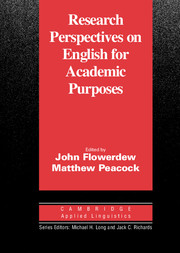Book contents
- Frontmatter
- Contents
- List of contributors
- Series editors' preface
- Preface
- I ISSUES IN ENGLISH FOR ACADEMIC PURPOSES
- II THE ENGLISH FOR ACADEMIC PURPOSES CURRICULUM
- Introduction to Part II
- 11 The EAP curriculum: Issues, methods, and challenges
- 12 Twenty years of needs analyses: Reflections on a personal journey
- 13 The curriculum renewal process in English for academic purposes programmes
- 14 Team-teaching in EAP: Changes and adaptations in the Birmingham approach
- 15 Does the emperor have no clothes? A re-examination of grammar in content-based instruction
- 16 The specialised vocabulary of English for academic purposes
- 17 Language learning strategies and EAP proficiency: Teacher views, student views, and test results
- 18 Issues in EAP test development: What one institution and its history tell us
- 19 Teaching writing for academic purposes
- 20 Reading academic English: Carrying learners across the lexical threshold
- 21 Incorporating reading into EAP writing courses
- 22 The development of EAP oral discussion ability
- 23 Second language lecture comprehension research in naturalistic controlled conditions
- 24 Designing tasks for developing study competence and study skills in English
- 25 Promoting EAP learner autonomy in a second language university context
- References
- Index
23 - Second language lecture comprehension research in naturalistic controlled conditions
Published online by Cambridge University Press: 05 October 2012
- Frontmatter
- Contents
- List of contributors
- Series editors' preface
- Preface
- I ISSUES IN ENGLISH FOR ACADEMIC PURPOSES
- II THE ENGLISH FOR ACADEMIC PURPOSES CURRICULUM
- Introduction to Part II
- 11 The EAP curriculum: Issues, methods, and challenges
- 12 Twenty years of needs analyses: Reflections on a personal journey
- 13 The curriculum renewal process in English for academic purposes programmes
- 14 Team-teaching in EAP: Changes and adaptations in the Birmingham approach
- 15 Does the emperor have no clothes? A re-examination of grammar in content-based instruction
- 16 The specialised vocabulary of English for academic purposes
- 17 Language learning strategies and EAP proficiency: Teacher views, student views, and test results
- 18 Issues in EAP test development: What one institution and its history tell us
- 19 Teaching writing for academic purposes
- 20 Reading academic English: Carrying learners across the lexical threshold
- 21 Incorporating reading into EAP writing courses
- 22 The development of EAP oral discussion ability
- 23 Second language lecture comprehension research in naturalistic controlled conditions
- 24 Designing tasks for developing study competence and study skills in English
- 25 Promoting EAP learner autonomy in a second language university context
- References
- Index
Summary
In the last twenty years, a large number of research studies have attempted to collect data on second language (L2) lecture comprehension in controlled conditions (see Chaudron, 1983; Chaudron and Richards, 1986; Chaudron, Loschy and Cook, 1994; Chiang and Dunkel, 1992; Dunkel, 1988a, 1988b; Dunkel, Mishra and Berliner, 1989; Dunkel and Davis, 1994; English, 1986; Flowerdew and Tauroza, 1995; Hansen and Jansen, 1994; Olsen and Huckin, 1990; Rost, 1994; Tauroza and Allison, 1994). In these studies, however, the subjects were given a lecture-like experience rather than observed while in a normal lecture. Tauroza (1998) analysed the studies to determine the extent that the lecture experience in the studies matches the way that students experience authentic lectures. From this review, it was apparent that many of the earlier studies were of questionable validity because the lecture experience presented to the subjects was clearly different from the way in which most students experience authentic lectures.
In this chapter, techniques for simulating authentic lectures in controlled conditions will be described. Following this, a recent research study that uses these techniques will be reported. This study will show that data can be collected in conditions that are both controlled and completely naturalistic. However, before moving on to these issues, it is pertinent to consider the following questions regarding the value of conducting research in controlled conditions: Given the problems relating to validity, why not simply forget about using controlled conditions in L2 lecture comprehension research?
- Type
- Chapter
- Information
- Research Perspectives on English for Academic Purposes , pp. 360 - 374Publisher: Cambridge University PressPrint publication year: 2001

